The bell tolls for Tsyvozero
Wednesday, October 17th, 2012I’m just back from a visit to the wonderful masterpiece of wooden architecture in the Archangel region of Northern Russia – the bell tower at Tsyvozero. I was joined by Alexander Popov, the restorer of wooden architecture based in Kirrilov, the wooden architecture enthusiast Andrei Pavlichenkov, the journalist and campaigner Alexander Mozhaev and my friend Alex Popov from St Petersburg. We were all horrified by what we saw.
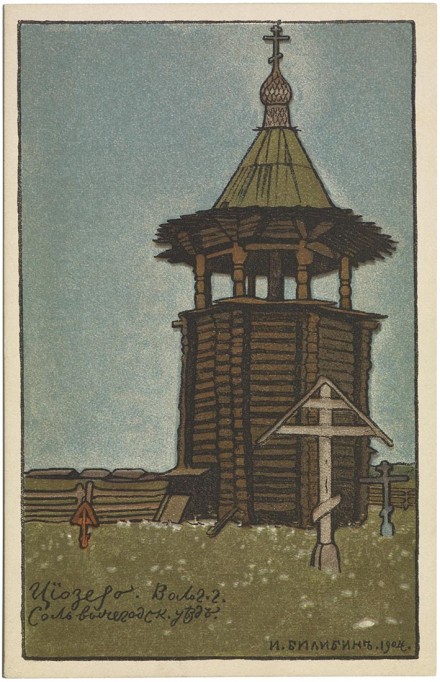
Bilibin’s Tsyvozero postcard pub. 1904
In 1904 the bell tower was described by Bilibin as ‘a most adorable tent bell tower… She is living her last days, she has leant over sideways and trembles in the wind. The bells have been taken from her.’
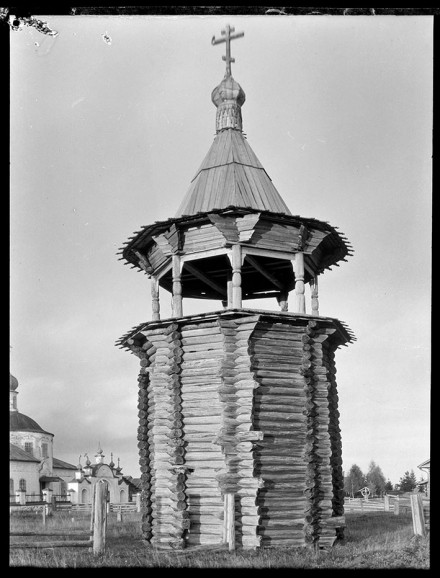
David Buxton’s photograph Tsyvozero 1932
In 1932 David Buxton wrote ‘In the evening it brightened up, and off I went to view the object of my visit â a delightful old wooden bell tower of the smallest dimensions, but pleasing in every way.’
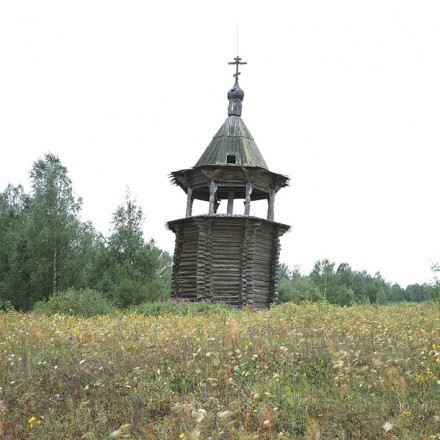
17th August 2002
When I first visited Tysvozero in 2002 the bells were certainly missing but the tower stood proud and erect, albeit dishevelled.
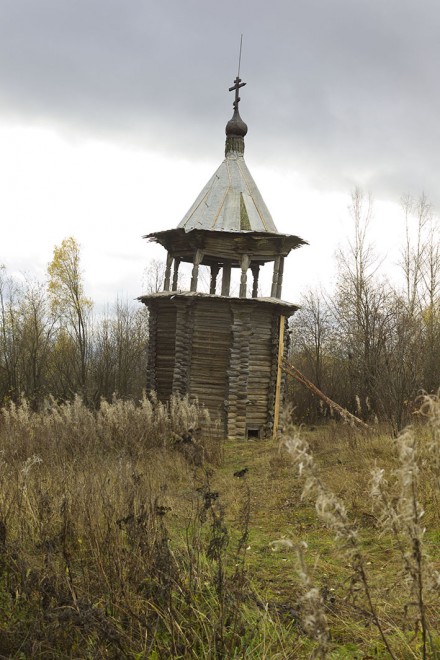
7th October 2012
This time, the 7th October 2012, the bell tower was showing her age. She was propped up, her roof battened down with roofing felt. Many of her logs were rotten or showing signs of rot. In 2002 I’d had no problem climbing within the tower, this time the stairs had collapsed and the route to the top was very precarious indeed. Concerned about the authorities neglect of this great work of Russian art local villagers had recently carried out the remedial work.
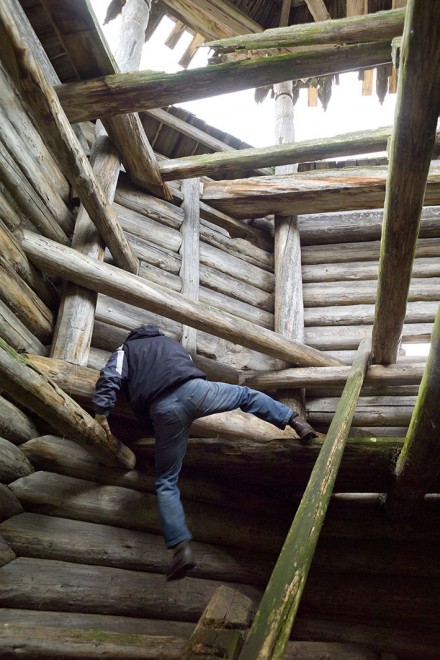
Alexander Popov
The purpose of our visit was to assess the structure with a view to obtaining permission to support the local people in their desire to restore the bell tower. We were confident that we could find backers in England and Russia to support the project. Alexander Popov, the restorer, is a great admirer of this beautiful bell tower and was keen to use his skills to preserve it.
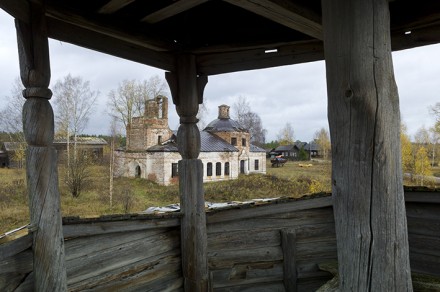
Having seen the bell tower we were all shocked and downhearted – what could be done? The project had seemed straightforward but now we wondered if Tsyvozero was beyond repair.
We spent the next few hours in Belaya Sluda with teachers from the school and kindergarden, Galina Kornyakova and Luibov Khabarova. We visited the schools famous Mushroom Museum and paid homage to the King of Mushrooms, who resplendent in all his finery, sat on his throne surrounded by his subjects. We saw an exhibition of ‘miracle vegetables’.

‘Miracle vegetables’ exhibition
The school proudly displays on it’s walls photographs and models of the local treasures – the Church of St Demitius of Thessolonika at Verknyaya Uftiuga that Popov had restored in the 1980′s (Luibov was thrilled to meet her hero) and of course the bell tower at Tysvozero. There was an old photograph of the Church of the Virgin of Vladimir at Belaya Sluda. It had been destroyed in 1962. Galina was eight years old at the time and remembers the thundery day. The church was hit by a single bolt of lightning and burst into flame. Men climbed onto the roof to throw down the burning timbers but the fire was too fierce and flamming like a huge out of control candle the church burnt to the ground. With Galina and Luibov we visited the site of the Virgin of Vladimir, I showed them Buxton’s photograph from 1932. Luibov became very excited, the photograph showed the railings in front of the church and the stone church that had survived. Luibov and the villagers have re-inhabited the stone church and she now wants to reinstate the railings. She has collected twenty seven of the original sections from around the village. The photograph showed that they had been placed slightly differently from how she had imagined!
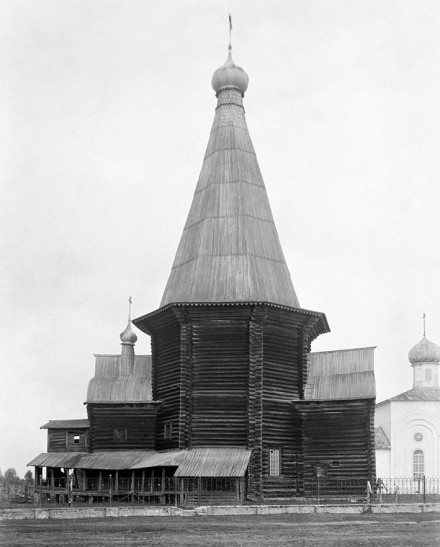
David Buxton’s photograph Belaya Sluda 1932
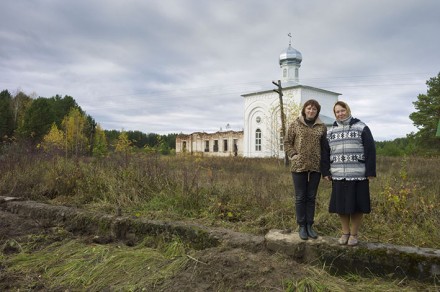
Luibov Khabarova and Galina Kornyakova
After tea, mushrooms and sweeties in the school staff room we set off to catch the last ferry back across the Dvina to Krasnoborsk.
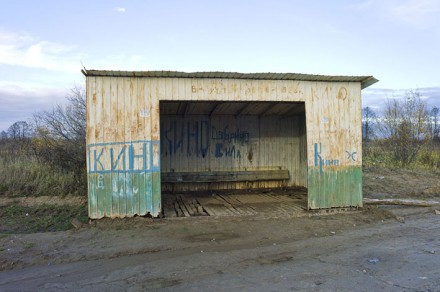
‘ĐинО’ Dvina ferry shelter

Dvina ferry to Krasnoborsk
On the drive back to our hotel in Veliky Ustiug Popov was disturbed and expressed his anger at what we had seen at Tsyvosero – how could this extraordinary icon of Russian wooden architecture be left to its fate without some effort being made to preserve it. Again we considered what could be done. We all agreed that ideally wooden architecture should be preserved were it stands, it has a greater resonace, but Tysvozero is almost beyond hope. It could be protected from the worst ravages of the elements with a canopy but it’s beauty would be destroyed. The ideal at this stage, we eventually agreed would to carry out a thorough survey of the bell tower, dismantle it and rebuild it in a purpose built top lit structure (the hall housing the Elgin marbles in the British Museum came to mind!). Sasha Moshaev suggested that the Tsyvozero bell tower replace the copy of Michaelangelo’s David under the dome of the Pushkin Museum in Moscow. An authentic Russian masterpiece replacing an academic sham. It would look magnificent! The Marble Hall at the Ethnographic Museum in St Petersburg would also be a perfect setting and a wonderful tribute to Bilibin. For during the early years of the last century Ivan Yakovlevich Bilibin collected artifacts, and recorded with photographs and paintings the folk art and wooden architecture of the North at the behest the Russian Museum.
A replica using the traditional working methods studied and perfected by Popov could then be built on the original site – it could safely be left in the hands of the local community whose young people have been encouraged and taught to appreciate and respect their heritage and homeland. In time the tower would accrue the patina of the old tower. Hung with a fine set of bells she would awaken new life and energy.